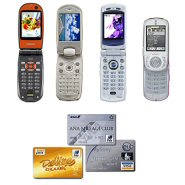Credit Cards Go Wireless on DoCoMo Felica Handsets
 Impulse credit card purchases are set to take a frighteningly mobile turn in Japan after NTT DoCoMo and the Sumitomo Mitsui Financial Group ended several days of speculation to formally announce a strategic business and capital alliance to bring credit card payments onto DoCoMo’s Felica IC-equipped handsets. DoCoMo plans to invest nearly 100 billion yen in the venture, acquiring 34 percent of Sumitomo Mitsui Card’s (SMC) common shares for approximately 98 billion yen (over $942 million), including new shares to be issued by SMC. The technology will be enable users to swipe their Felica handset in front of a code reader and confirm credit card purchases automatically. No definite rollout date was given.
Impulse credit card purchases are set to take a frighteningly mobile turn in Japan after NTT DoCoMo and the Sumitomo Mitsui Financial Group ended several days of speculation to formally announce a strategic business and capital alliance to bring credit card payments onto DoCoMo’s Felica IC-equipped handsets. DoCoMo plans to invest nearly 100 billion yen in the venture, acquiring 34 percent of Sumitomo Mitsui Card’s (SMC) common shares for approximately 98 billion yen (over $942 million), including new shares to be issued by SMC. The technology will be enable users to swipe their Felica handset in front of a code reader and confirm credit card purchases automatically. No definite rollout date was given.
Sure, it’ll be convenient — but is it secure?
A hurried press conference held 27 April at DoCoMo offices in Tokyo’s Otemachi district outlined details of the joint platform, which will include a DoCoMo-branded credit card to be used in conjunction with the Sumitomo Mitsui Card (they are part of the Visa Japan and Visa International groups).
DoCoMo will rely on Sumitomo Mitsui Card to leverage its credit-card expertise in establishing infrastructure for mobile credit-card payments plus shoulder the burden of installing terminals at member retail shops nationwide. Another member of the group, Sumitomo Mitsui Banking Corporation (SMBC), has agreed to develop ATMs (automated teller machines) compatible with the DoCoMo handsets. They are Japan’s second-largest bank behind the Mizuho group.
Later this year, mass transit meets mobile technology via the DoCoMo Mobile Suica service incorporating Japan Rail IC train commuter cards directly into i-mode FeliCa-equipped phones. Payment options may at some point now include credit cards as well as e-money accounts.
Credit card security has a to be a major concern in this venture. Remote scanners that could possibly hijack cell phone data may transition from sci-fi stories to horror documentaries. The Bank of Tokyo Mitsubishi has introduced biometric ID scanners for its ATM cards and DoCoMo already has fingerprint-scanning technology for handsets. Banks are also reportedly considering some form of optional individual insurance coverage to protect deposits from fraud as well. Some sort of fusion of all these measures may be necessary by Sumitomo Mitsui Card and DoCoMo to address very real fears of potential mobile credit card fraud.
At the press conference, DoCoMo announced plans to leverage new credit card applications by merging them with existing FeliCa services, and the aim, clearly, has to be boosting the bottom line.
DoCoMo has had an expensive year; shares have shown a steady decline since ’04 and the company is expected to post substantial losses due to falling profits and rising development costs. And while data revenue is up, voice communication revenue has fallen. These huge corporate tie-ups and new mobile applications make for media headlines but what about income? Right now FeliCa is less of a business model and more of a grand experiment in fast digital retailing. The “Build it and they will find it on their handsets” approach to marketing that DoCoMo has specialized in may not cut it with satisfied-with-cash consumers.
In any event, linking FeliCa with credit cards should at least provide a revenue source as DoCoMo takes in a small percentage of the fees. The Nihon Keizai Business Daily estimates Japan’s credit card and cash advance market at over 34 trillion yen. Sumitomo Mitsui hopes to drive that number higher with new credit options for millions of DoCoMo customers.
— Gail Nakada

